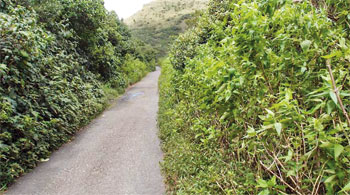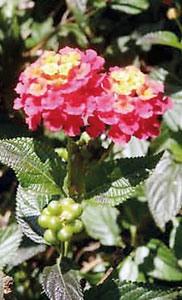Invasive species are now widely regarded as the second most important threat to biodiversity, after habitat destruction (hunting, timber extraction etc.). The impacts of invasive species are particularly severe on small island ecosystems. Island ecosystems display many special characteristics, many of which result from the relative isolation of islands from other landmasses and the difficulties that animals and plants experience in dispersing naturally across the sea.
Invasive plant species are one of the greatest threats to croplands, forests, aquatic and natural environment in Sri Lanka. They degrade and destroy the productivity and biological diversity of all ecosystems. The problem increases each year as new species are introduced and established. We have seen so many of the world’s worst plant species established in Sri Lanka such as the water hyacinth, salvinia, lantana, alligator weed, giant mimosa, miconia, parthenium etc.
We can overcome and reverse this trend only if we are willing to commit and use national resources to combat the problem. The formula for success must include a coordinated approach at the federal, institutional and private sector levels that will involve long term commitments of adequate planning, funding, scientists and facilities to produce results based on sound science.
 |
| Alien invasive plants growing in Knuckles Mountain range |
Throughout the last century, large numbers of damaging plants have been introduced into and established in Sri Lanka. Those introductions range from accidental such as weed seed contamination of commodities to purposeful, such as water hyacinth and other plant species introduced as ornamental plants. Regardless of the mode of entry of these introductions, the public has suffered economic losses to food production, deterioration of natural resources (wild lands, aquatic, riparian and forests), loss of native species and their habitat, and further economic losses due to restrictions on the export of pest contaminated commodities.
The risk of injurious introductions of undesirable plants has accelerated in the last three decades due to exponential increases in air travel, increased ports of entry, expanded export/import to international markets and increased access to foreign plants via internet (e-bay). Through commercial air-cargo, ship ballast water and private travel, non-native plant species are brought into Sri Lanka each year.
A step by step approach to protecting ecosystems for invasive plant species should include:
n Predicting which species are likely to enter Sri Lanka and successfully erecting barriers (regulation, inspection, and quarantine, destruction) to prevent entry of those species.
Implementing specific site management and control measures to prevent establishment and spread from sites of initial introduction.
Developing management zones in sites of establishment to initiate control and prevent spread to new areas.
Prevention of the introduction of known pests and the establishment of newly introduced invasive plant species are economical and rational approaches to stopping the spread of invaders before they become economically damaging to the environment.
Wholesalers and retailers often are not knowledgeable enough to distinguish between native and exotic species. There is no adequate educational programme to ensure that retailers are fully aware of import restrictions that allow for proper identification of plants, or provide information on where to report suspect species. The end-user knowledge base and awareness levels of invasive plants are limited. Many managers are aware of problematic species; however the average property owner is poorly informed.
The historical record clearly demonstrates that the widespread introduction, distribution and in some cases, promotion of many environmentally costly exotic plants were made by government agencies or by well intentioned commercial growers and suppliers. Prevention programmes for invasive plant species must include enforcement and controls coupled with adequate education throughout the entire sequence of importation.
Public education and awareness
Awareness of invasive plant species and the problems they caused will help the general public, policy and lawmakers, administrators and land managers understand why the development of long term weed management programmes is critical to protect the environment. Communicating the impacts of invasive plant species, their correct identification and the management tools available to land managers will aid in development of management plans at all levels of ownership.
 |
Lantana camara
introduced to Sri Lanka via the Royal Botanical Gardens at Peradeniya
in 1926 as an ornamental plant |
Educational efforts are being made through academic institutions, industry, commodity groups and farm and non-profit organizations to enhance awareness of the threats associated with invasive weeds as biological pollutants and the methods of dispersal of pest plants as contaminants of agricultural and horticultural commodities. These can be accomplished through brochures, posters, internet websites, scientific papers and other written media with educational programmes for landowners, land managers or the general public.
Recent educational efforts that have improved public awareness of invasive plants can be found in Sri Lanka. For example, excellent printed materials and roadside billboards educating the public about invasive plants ouch as “parthenium” in Suriyawewa and Mannar areas. Unfortunately, for most exotic species, the level of awareness among the general public is low.
Early detection, monitoring
and reporting
Early detection means locating, identifying and documenting newly introduced species. This is essential to reduce the long-term economic impact of new invading species. It is critical that early identification and monitoring be accurate and timely. Detected invaders must be identified and reported to an appropriate organization to allow for initiation of assessment and response. Centralized monitoring programmes could pool all available information on an invasive plant species and help in evaluating the success or failure of weed management programmes.
Reporting requirements allow all available information on invasive plant species to be documented and shared with land owners.
The best management of invasive species problem is to recognize the potential problems early and manage/control them before they reproduce, spread and established their population. Then monitor the site regularly to maintain adequate follow up control. Early detection depends on proper training of land managers, pest management professionals/officers and property owners. Understanding the potential threats that may exist on surrounding property and in aquatic systems can provide motivation for the public to provide an early warning system for weed invasion.
Among invasive weed species, the parthenium weed management programme was the most visible and organized work conducted in the country. Considering the difficulty in predicting the invasive potential of introduced species, it is therefore essential to look at the reasons and justifications for introducing plant species. Many of the plants introduced to Sri Lanka over the last 200 years have been beneficial to us and ecologically benign. But a small percentage of species has run rampant. Gaining a foothold in areas distributed by human activities, they have moved into natural areas where they may radically alter the ecosystems they have invaded. 80% of the plants that have naturalised in Sri Lanka over the last 100 years have been introduced deliberately for ornamental purposes (water hyacinth, mist flower, miconia, lantana, gorse etc.). The sources of these introductions include botanical gardens, government and private nurseries and importers.
All introductions of exotic species should be screened with great care in a process, which considered the status in the native range and at other points of introduction. In the past, pest management agencies tended to adopt a reactive approach to pest management, allocating most of the available control resources to the containment or biological control of widely naturalised species. The importation of additional weed species and the sale and cultivation of potential weeds was virtually ignored. It could be said that such as approach was analogous to “mopping up the spill while the tap was still running”. Today it is becoming apparent that increased attention should be paid to the precautionary principle and a philosophy of prevention rather than cure.
Weed risk assessment
There should be a system of assessment of all new plant species proposed for importation into Sri Lanka including seeds and live material of terrestrial and aquatic plants. The Sri Lankan quarantine should adopt a screening system for weed risk assessment. This system considers a species’ biological attributes (including reproductive characteristics), its history as a weed elsewhere and its climatic preference. Based on these criteria, a candidate species is assigned a numerical “score” and is either rejected, assessed in more detail or approved for importation, depending on its score.
The writer is an invasive plants specialist, Melbourne, Australia. |



